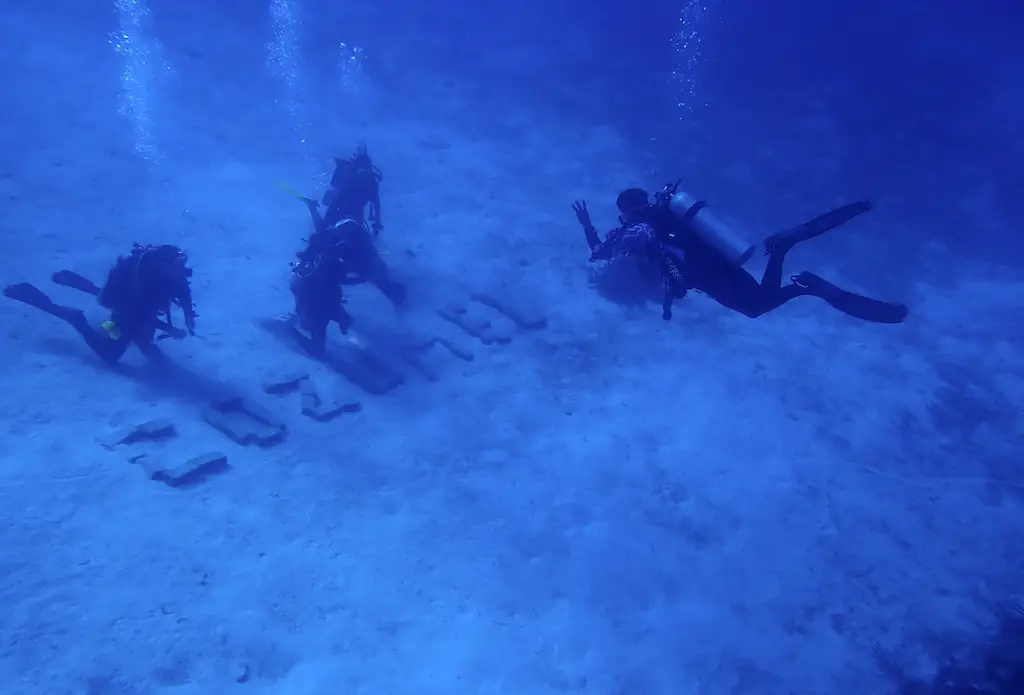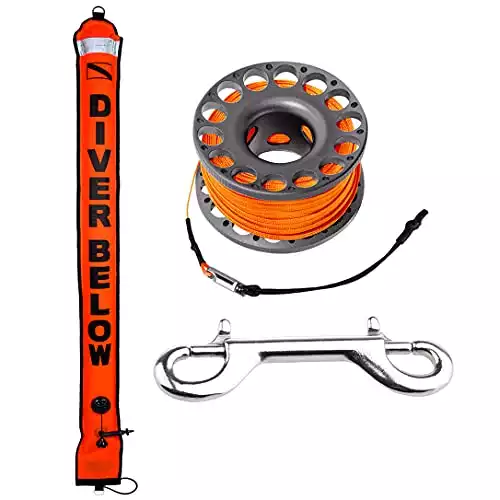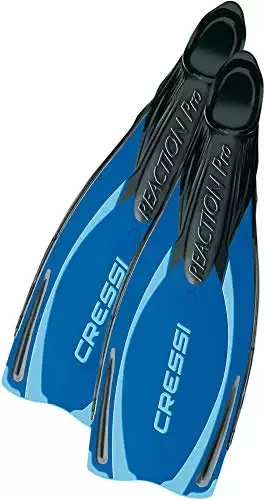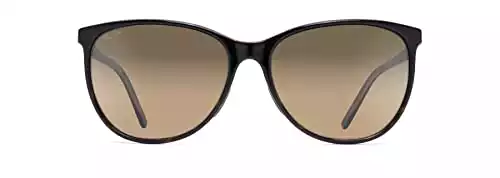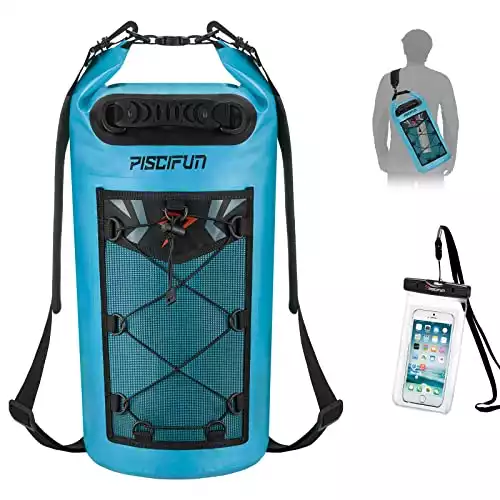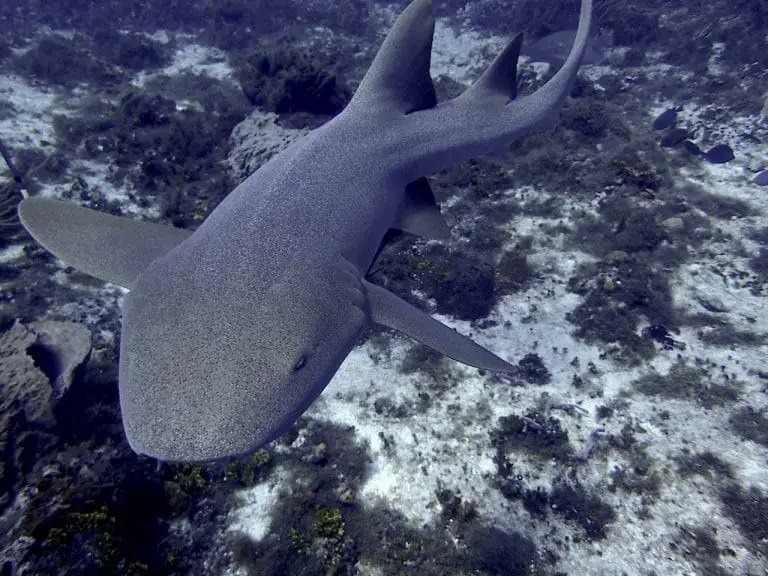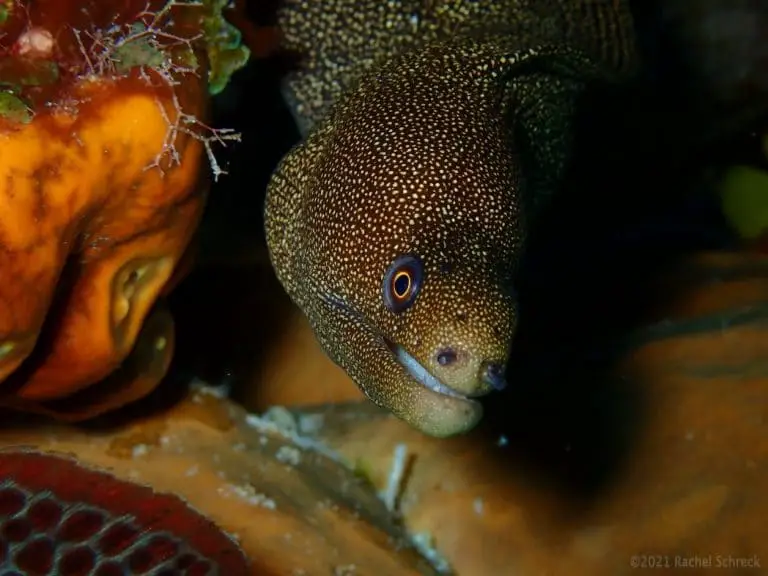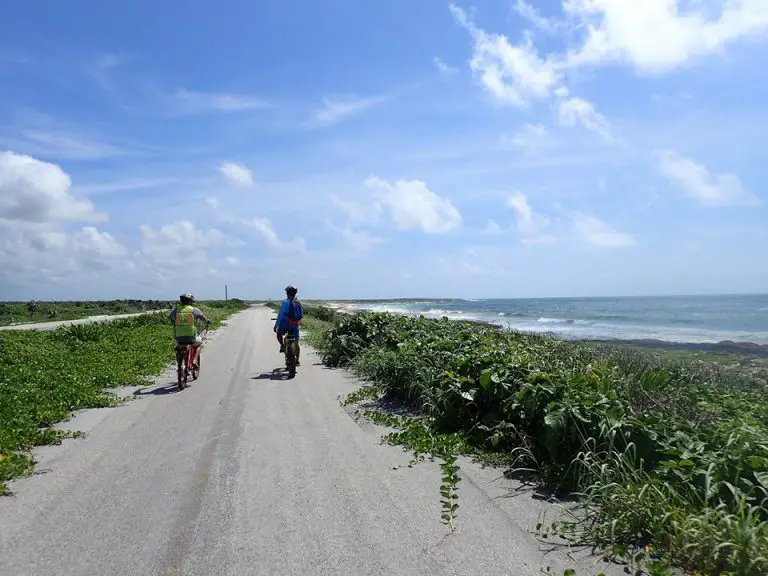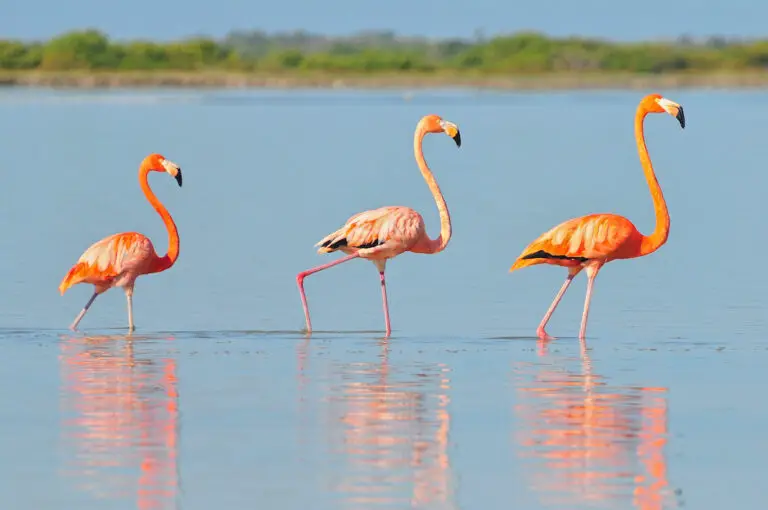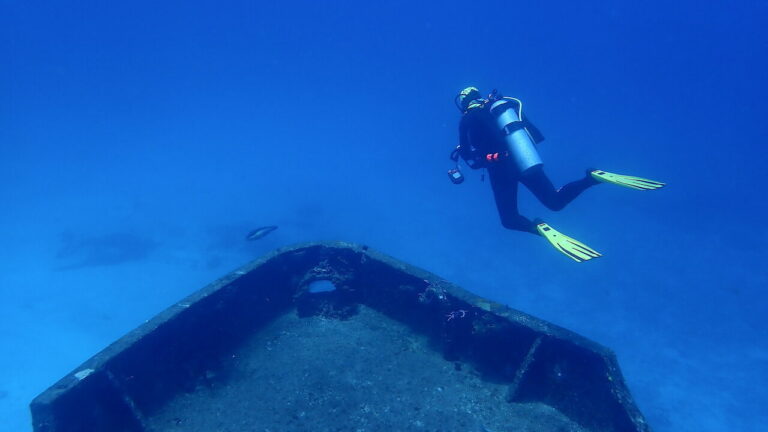Easy Guide to Drift Diving in Cozumel Currents: Don’t Fear the Drift
Considering you first dive trip to Cozumel, but a little scared off by Cozumel’s currents?
For new scuba divers, Cozumel has a (somewhat exaggerated, at times) reputation for strong currents and occasionally “wild” drift dives.
Naturally, the idea of venturing into the open ocean and navigating strong currents can be intimidating, especially when you’re just starting out.
Drift diving, in general, can pose a unique set of skill-building and challenges that require additional techniques and knowledge.
But overall, it’s really easy and fun diving, once you know the basics.
Exploring the underwater world in Cozumel is a thrilling and rewarding experience, especially if you’re an experienced diver.
Scuba Diving in Cozumel = Excellent and Easy
Cozumel scuba diving is terrific. The island’s protected national marine park has stellar underwater visibility and warm clear water all year round, plus an abundance of beautiful coral reef formations and diverse marine life. What’s not to love?
After all, Cozumel wouldn’t consistently rank among readers’ choice awards every year if it was a trecherous grind that can only be enjoyed by expert divers!
New divers, divemaster trainees, and recreational divers from all over the world love it here, and keep coming back in droves, year after excellent year.
Frankly I’ve been lucky to dive in some amazing places including the GBR, Cuba, and Palau, and I’m always happy to return to my home away from home, and dive my favorite Cozumel dive sites again.
Cozumel is always a contender. Not to mention fun, friendly, and relatively frugal.
Read on about the world of drift diving in Cozumel, what makes this type of diving so exciting and rewarding, and the skills and equipment needed to do it safely and confidently.
Whether you’re new to diving or a seasoned pro, read on to discover the beauty and excitement of drift diving in Cozumel.
What is Drift Diving in Cozumel?
Drift diving means diving in a steady current where you enter the water in one location and exit at another.
When you’re scuba diving in Cozumel, Mexico, that typically means entering the water from a dive boat, drifting along the coral reef formations of your chosen dive site, surfacing when you’ve dived your tank, and being picked up by your boat waiting for you at the end.
This works by allowing you to be carried by the current, which can provide a chill experience of floating effortlessly through the water, watching the underwater scene slowly glide by.
However, if the current is a bit strong, it can move into more, er…, thrilling territory!
And this also requires you to have solid buoyancy control and the ability to navigate in the current, as well as an understanding of a few safety protocols.
Introduction to Drift Diving in Cozumel’s Ocean Currents
Among the first things to know about Cozumel’s currents is that they are not (always) constant.
Normally, diving Cozumel means you’ll do a giant stride or back-roll entry from your dive boat, gently drift with your dive group from south-to-north along your dive site, and take in all the corals and critters you can spot.
Then, after 45 minutes to an hour (depending on your experience and air consumption), the group will do a 3-minute safety stop, and carefully surface near their dive guide’s surface marker buoy (SMB), and wait for their boat to swing around and pick them up.
Easy as pie.
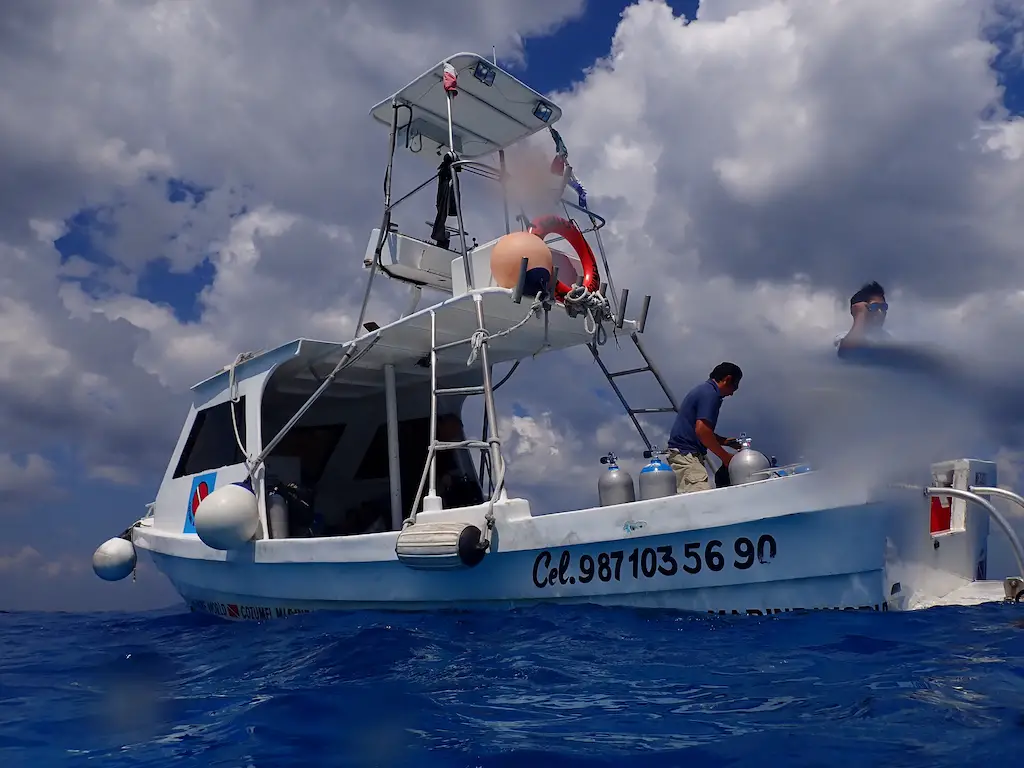
On some days, the ocean currents in Cozumel are more dynamic and can change quickly, even during a single dive.
This is why it’s important to have an experienced dive professional with you, who can read the currents and adjust your dive plan accordingly.
However, don’t let this deter you from trying drift diving.
Being carried along by the current can be a thrill if the currents are ripping, but more often than not, it provides for the most lazy, relaxing kind of diving where you just drift along while surrounded by vibrant marine life and beautiful coral formations.
In fact, most experienced divers who do a lot of drift diving joke about how easy it is, and that they don’t even need to kick!
Talk about maximizing your tank air consumption!
Most of the time, Cozumel’s drift diving is easy and fun, and the best part is, you don’t even have to navigate back to the anchor line or your entry point.
Cozumel’s experienced boat captains will trail your group, and 99% of the time be waiting for you right where you surface at the end of the dive.
It is really fun, and allows you to cover more ground and see more sea life, overall.
With the proper information, training and a few pieces of key equipment, you’ll feel confident and safe exploring Cozumel’s protected national marine park whether the currents are mild or strong that day.
So, don’t be afraid to take the plunge and experience the rush (or relaxation!) of drift diving in Cozumel. After all, it’s one of the most popular dive spots in the world, and it is NOT only reserved for advanced divers.
Diving Skills Needed for Drift Diving in Cozumel
To successfully navigate the underwater terrain in this location, it’s important that you have your open water diving certification from a reputable dive shop.
Next, you should rent or buy dive equipment that fits properly and is in good working order. If you’re renting, take the time to make sure your B.C.D. fits snugly but allows a range of motion, and that your fins feel secure without any pinch points, etc.
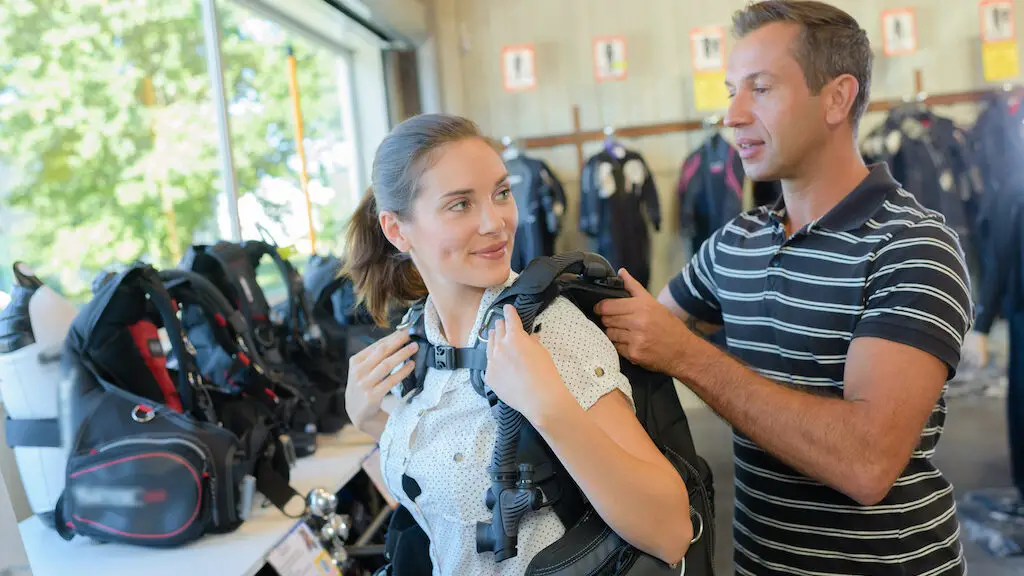
As you drift with the current, it’s also important to always keep your surroundings in mind, including your depth, location, and direction of the current.
You should always pay attention and always be aware of potential hazards like coral, rocks, or other divers in your vicinity.
Ideally, you’ve also developed a strong sense of spatial awareness and the ability to adapt quickly to changing environments – but don’t worry if you’re a beginner, these things come with more diving practice!
As will diving skills like being able to control your buoyancy and maintain a steady depth, as well as having good finning techniques to help you maneuver through the current.
Controlling Buoyancy is Especially Crucial while Drift Diving:
1. Use proper weighting
Certified divers should always wear the appropriate amount of weight to ensure neutral buoyancy. This means they neither sink nor float in the water.
Always do a weight check from the shore if this is your first dive in a long time, or if you’ve recently gained or lost a lot of weight.
Also, if you’re wearing a new wetsuit or are used to diving in cold water, a quick weight test in the water to make sure you’re properly weighted right from the start can prevent a host of issues on your dives, and give you more confidence as you experience some of the best drift diving around.
2. Adjust breathing
By controlling their breathing, divers can improve air consumption, and also get better and better at fine-tuning their buoyancy control.
Inhaling deeply increases buoyancy, while exhaling decreases it.
Ideally, you’ll have practiced this in your certification classes and initial check-out dives, and have some more experience in calm water to really get the hang of it. But going into a drift dive for the first time, review the concepts from class, and really focus on getting your buoyancy dialed in, quickly.
3. Master use of a buoyancy compensator device (BCD)
A BCD is a vest-like device with an internal air bladder that can be inflated or deflated to control buoyancy.
Getting a well-fitting BCD and getting comfortable with it’s use is probably the key skill in diving. Achieving and maintaining neutral buoyancy at all times is the whole trick of good diving.
4. Adjust fins and body position
Divers can also control their buoyancy by adjusting their fins and body position for good “trim” in the water column.
A horizontal body position with arms tucked in and fins behind you and level helps maintain neutral buoyancy, as well as the ideal position to see what’s coming in front of you, and your ability to navigate with a minimum of body movements and flailing around.

With these buoyancy skills, you’ll be able to safely and confidently explore the beautiful world of Cozumel’s coral reefs.
If you’re new to scuba diving in Cozumel – or diving in general – just relax, greet, and talk to your assigned dive guide about your experience and questions, and make sure to listen (!) to the dive briefings before each dive.
The dive boat captains and dive masters in Cozumel are very familiar with the local currents, and they understand which sites are the easiest and safest during wind conditions that affect currents, so they will choose dive sites with safety and their group’s skill levels in mind.
Trust them and stay near them on the dives, and you’ll be fine.
Essential SCUBA Equipment for Drift Diving in Cozumel
When exploring the underwater world of Cozumel, it’s crucial to have the right gear to keep you safe and comfortable.
Dive Computer to Monitor Depth
One of the most important pieces of equipment for drift diving is a dive computer.
This device allows you to constantly monitor your depth and bottom time, as well as track your nitrogen levels and avoid going into deco prematurely.
It’s important to choose a dive computer that is easy to read and understand, and that has features that match your level of diving.
Sometimes the currents can even push you downward, but it’s very hard to detect, so having this piece of equipment on your wrist or your console allows you to check your status in the water at all times, and make sure you’re not going too deep for too long.
This is the exact model I’ve used from beginner through about 2k dives.
Surface Marker Buoy (SMB)
Another essential piece of equipment for drift diving is a surface marker buoy (SMB), also known as a “safety sausage” or “diver-down buoy”, etc.
This is a brightly colored inflatable buoy that you deploy at the end of your dive to signal your location to the boat.
When drift diving, it’s not unheard of to become separated from your group due to the strong currents, so an SMB is an important safety tool.
As we covered in our post about recommended diver safety equipment (link here), your SMB is a key piece of dive gear for all but the newest divers in Cozumel.
An SMB is important because it signals to boats and other divers that there are divers in the area, and helps them avoid potential collisions or other safety hazards.
Additionally, in the event of a drift dive where the current may carry divers away from the boat or dive site, an SMB can be used to alert the boat crew to the diver’s location and bring them back to the surface safely.
It is important for divers to be trained in the proper use of SMBs and to carry one with them on each dive.
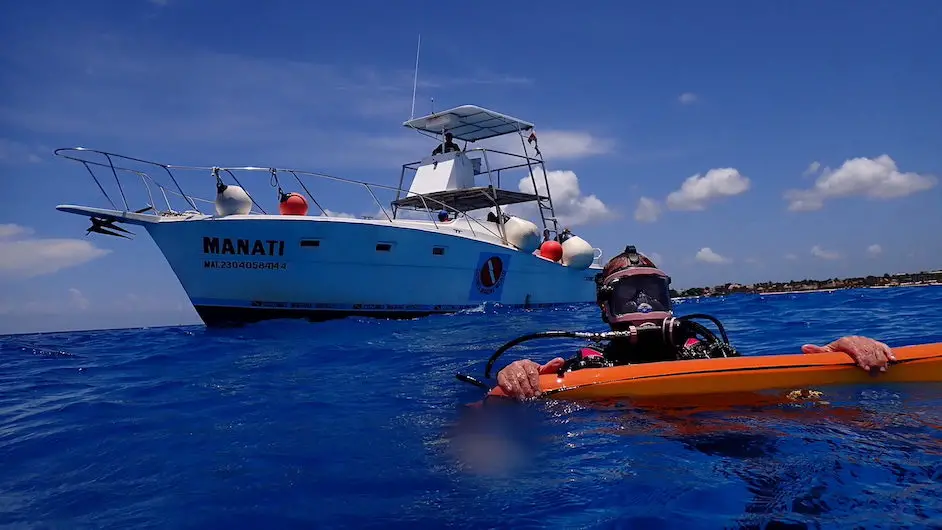
Good Fins for SCUBA Diving in Cozumel
In scuba diving it’s often said that your fins are you power.
When you approach the boat at the end of a dive, the fins are what you remove last before climbing up the boat ladder. Why?
Well if you take your fins off and then lost your grip on the boat, or make room for another diver, then all of a sudden you’re trying to swim in a current without the strength of those find. No bueno.
During a drift dive, the fins perform the same function – allowing you to swim and maneuver with much greater power and precision than with just your feet.
Your fins should fit snugly without any pain points and offer you a good strong kick without causing cramps in your calves or legs.
Rental fins can be fine, though many times they are not quite as robust as dive pros’ fins. In a strong current they are sometimes inadequate.
Ask your rental shop about the fins’ rating, and make sure they know you need a pair that will be appropriate for a drift diving environment.
These are the fins I wear in Cozumel:
Good Weather App that Focuses on Wind
The main driver of currents in Cozumel is the wind.
Most weather forecast apps might show general wind speeds, but to really anticipate the diving conditions in a given area, it’s best to use a weather tool that drills down on specific wind speeds, directions, and fluctuations.
The best app to download to your phone for local Cozumel diving conditions is either Windguru, or the even more user-friendly Windy app.
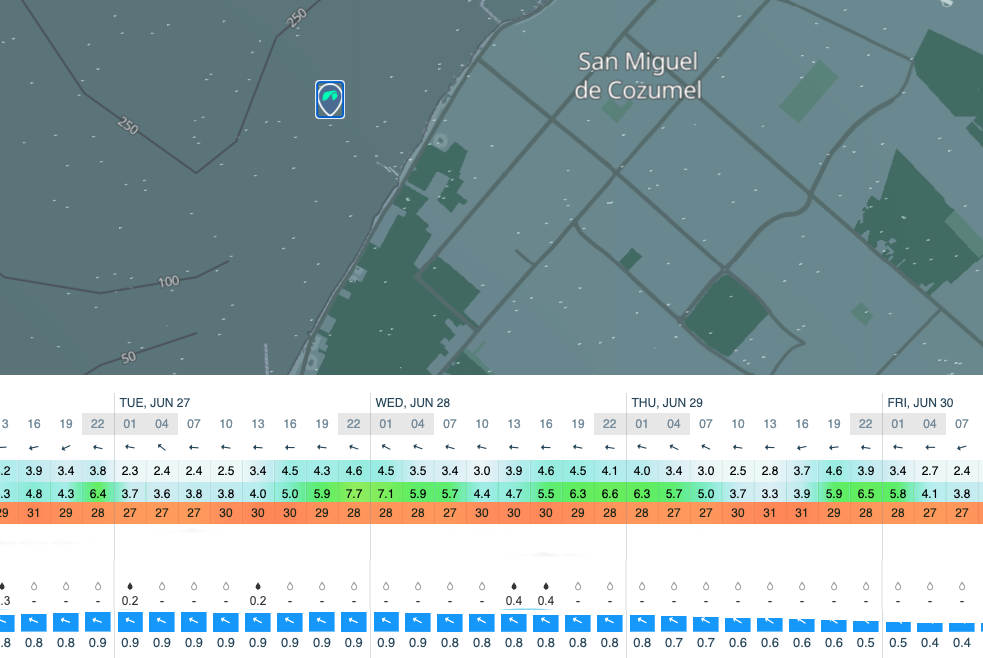
Windy gives you hour-by-hour wind data, as well as temperature, cloud cover, anticipated rain, and more. There is a paid Pro version, but the free version works great for this – it should be all you need.
In these parts, these conditions can change on a dime, too, so it’s great to have on your phone for near real-time information on the ocean. (there are two Windys in the app store. Both are great, but the one with the blue logo is the one shown here, and has this grid layout that I find the most useful for diving).
Your DAN Diver’s Insurance Card (up to date!)
Last but not least, the most important piece of gear in your dive bag is your DAN diver’s medical insurance membership card.
If you ever have any dive-related injuries or need Oxygen therapy or a few rides in the decompression chamber, DAN has your back – and for peanuts, really!
Join to protect yourself, and join to support all the leading research and guidance DAN’s dive medicine specialists provide to our sport. It’s a no-brainer, so get it done NOW.
The most important piece of dive gear in your kit.
Use the Cozumel Coral Reef to Your Advantage
By utilizing the natural formations of the reef, you can glide effortlessly through the water and experience the mesmerizing beauty of the underwater world in Cozumel.
The reefs in Cozumel are an ideal structure for drift diving, as they provide a natural current break and shelter from the strong currents. Divers can use the reef as a guide and allow the current to carry them along, while still being protected from the strong currents.
By maneuvering to and ducking down behind a coral head or rock formation, you can allow the ocean current to wash over you without taking you along with it. This skill requires practice and precision, but it can make a significant difference in your diving experience.
One of the biggest advantages of using the reef to your advantage is the opportunity to observe marine life without disturbing their natural habitat.
The formations of the reef create sheltered areas where fish and other marine creatures can rest and feed.
By using the reef as a guide, you can float above these areas and watch the animals go about their daily lives without disturbing them. The natural formations of the reef also create interesting nooks and crannies to explore, adding to the excitement of the dive.
Drift Diver: Don’t Fight the Cozumel Currents
Don’t fight the current.
Avoid struggling against the strong currents in the water. Instead, relax and allow them to carry you along with ease.
It may be tempting to fight against the current, and there are moments when you might have to to stay with your guide, but doing for any length of time will only tire you out, increase your air consumption rate, and make your dive more difficult.
Instead, embrace the current and use it to your advantage.
First off, you can turn and gently kick to swim against the current, giving you a little resistance to kick against and allowing you to hover in place as you wait for your dive buddy/group, or if you want to slow down and look at some interesting marine life for a minute.
Think of it like being on a treadmill, or walking up the down escalator – your effort is not great, but you can manage to calmly stay in one place and keep a steady pace without over-exerting yourself.
However, most of the time, drift diving is all about going with the flow, quite literally, and letting the underwater currents take you where they will.
As you drift along, keep an eye out for any interesting marine life or unique coral formations that you may not have noticed otherwise.
By not fighting against the current, you’ll be able to conserve your energy and stay underwater for longer periods of time, which means more time to explore the beautiful underwater world of Cozumel.
So, remember to relax, go with the flow, and enjoy the ride.
Cozumel Scuba Dive Sites – Ask for Dive Sites with “Terra Firma”
Some of the best dive sites in Cozumel are wall dives or dives among mountainous coral formations that descend well into the deep. And they are amazing.
But plenty of other awesome dive sites in Cozumel are over a nice firm sandy ocean floor!
My original dive instructor brings new divers to Cozumel all the time, and for the first few days – strong currents or not – he requests all sites with a firm ‘floor’, just in case.
Having a solid and stable foundation takes some fear and danger out of the situation, ensuring your safety and comfort underwater.
By starting your trip with an easy Cozumel shore dive to get used to the feeling, and then requesting boat dive sites without a deep wall or drop off, you can simply avoid these potential hazards and enjoy a more comfortable and relaxing dive.
Shallow dive sites with solid foundations also tend to have more diverse and abundant marine life, as they provide a stable environment for corals and other organisms to grow.
If you’re into macro marine life like amazing sea slugs or ornate cleaner shrimp, and perhaps learning to take underwater photos, these shallow sites are typically the most fruitful!
And don’t be fooled – tons of fish and other sea life live in sandy areas or seagrass beds, so these dives are still among the best dive sites in the marine park, and full of incredible marine animals, from our local population of spotted eagle rays to Cozumel’s signature splendid toadfish. (for more, read up on our local mascot, the splendid toadfish, right here.)
Dive sites that are shallower and over a solid ocean floor can offer a unique and rewarding diving experience, as you explore vibrant coral formations and encounter a wide variety of fish and other camouflaged creatures that live in every nook and cranny of the reef.
So, when planning your next drift diving adventure in Cozumel, make sure to prioritize dive sites with terra firma – at least at first – and experience the best that this beautiful destination has to offer, without some added stressors.
Best Shallow Cozumel Dive Sites with Solid Ocean Floor
- Columbia Shallows
- Palancar Gardens (on the interior side of the reef)
- La Francesa
- Punta Dalila
- Santa Rosa Shallows
- San Clemente
- Yucab
Glimpsing Cozumel’s Diverse Marine Life During Drift Dives
Now it’s time to get ready to experience the thrill of Cozumel’s currents and diverse marine life during drift dives.
As you drift along with the current, you’ll have the chance to witness an array of marine creatures, including Atlantic nurse sharks, an array of colorful tropical fish, a variety of moray eels, and vibrant coral formations.
And don’t miss our wonderful resident sea turtles – hawksbill, greens, and loggerheads all reside in Cozumel (read our full guide to Cozumel sea turtles right here).
One of the most exciting things about drift diving is that you never know what you might encounter.
As you glide through the water, one minute you’ll be surrounded by schools of fish darting in and out of the coral, while sea fans and soft gorgonian corals sway in the current.
The next, you’ll be face to face with a loggerhead sea turtle, a barracuda, or a moray eel ribboning its way in and out of the reef, hunting for food.
Be sure to keep your eyes peeled for larger creatures, like eagle rays and nurse sharks, that might pass by in the distance.
And always stay close behind your dive guide, too, so s/he can point out interesting local species that might have secret hiding places.
Drift diving in Cozumel is truly a unique experience that allows you to immerse yourself in the beauty of the underwater world, and take in a new parade of colorful life that inhabits this stretch of the Mesoamerican barrier reef.
Keep Your Diver Buddy Formation Tighter in a Strong Current
Maintaining a close buddy formation is crucial for ensuring safety and maximizing enjoyment during your underwater adventure in Cozumel.
While most of the time you’ll have the relaxing day of diving described above, the currents in Cozumel can indeed become strong and unpredictable.
It’s important to stay close to your dive partner at all times, especially on days when the direction of the current is shifting around or stronger than usual.
This will help you navigate through the currents together, and also ensure that you can quickly assist each other in case of an emergency.
This will allow you to keep a close eye on each other and communicate more effectively using hand signals.
Additionally, it’s important to really listen to each dive briefing as you gear up, and have some pre-dive communication with your buddy to discuss the dive plan, each other’s gear check, and review any anticipated emergency procedures.
By sticking together, staying close to your experienced dive professional, and communicating effectively, you can make the most of your drift diving experience in Cozumel while also staying safe.
When the Cozumel Currents are Too Strong
OK, so often the talk of Cozumel’s currents can be exaggerated.
On the other hand, if the wind is up and there is weather in the area, the Cozumel currents can definitely get very, very strong.
In the worst of these cases, the local officials and harbor master will be monitoring the strong winds, and declare the port closed to small boats and watercraft, and prohibit water sports like diving, snorkeling, and kitesurfing or SUP in the area.
At times, the weather may seem fine on land and people question the decision, but over the years I’ve grown to appreciate the caution typically used when the port is closed, and remind myself that it’s way better to be safe than sorry, especially where SCUBA diving is concerned.
However, even if the port is open, you may still go diving, do a typical entry and descent, and then realize that the current is really strong that day, or that it is shifting in weird directions – including downward! – and so on.
In Cozumel, the currents can change quickly and become unpredictable, so it’s crucial to stay calm, pay attention to your dive briefings, keep an eye on your divemaster, carry a SMB with you, and have a plan in place if you and your buddy become separated.
DO Watch Out for Down Currents
Be careful of sudden downward movements in the water, as they can quickly take you deeper and potentially cause harm.
Down currents are not a common occurrence in Cozumel, but it can and does happen, especially in areas and dive sites where strong currents meet deep drop-offs.
These down drafts can be caused by a variety of factors, including tidal changes, underwater topography, and your proximity to the reef substrate.
To avoid getting caught in a down current, it’s important to stay alert and aware of your surroundings.
Keep an eye out for signs of a down current, such as debris or sand being stirred up from the bottom, odd swimming behavior of fish, or a sudden change in water temperature.
If you do find yourself in a down current, don’t panic.
Instead, continue to breathe at a slow steady pace, stay calm, add some air to your BCD, and kick up and at an angle to the current’s flow until you can escape the pull of the downward current. (Once you do, be sure to deflate your BCD as appropriate to avoid ascending too quickly once you’re free of the current’s pressure!).
A strong down current is also the one time when trying to grab hold of a rocky ledge or the reef’s limestone base – or even part of the coral reef itself if necessary – is permitted and indeed recommended, if it keeps you from descending in an uncontrolled manner.
In that scenario, the diver’s safety is paramount.
Remember, the key to safe and enjoyable drift diving in Cozumel’s currents is always to respect the power of the water and stay prepared for anything that may come your way.
Remember Your #1 Key Dive Training Rule: Breathe and Don’t Panic
It’s crucial to remember to stay calm and breathe steadily if you find yourself in a challenging underwater situation. This is particularly important when diving in any strong currents of Cozumel.
When you feel the powerful pull of the water, it can be easy to panic and start breathing rapidly, but this will only make things worse.
Instead, focus on taking slow, deep breaths and maintaining a steady rhythm. This will help you conserve your air and control your movements.
Remember that the current will eventually pass, and you can use it to your advantage by adjusting your position and using less energy to move around.
By staying calm and breathing steadily, you’ll be able to enjoy the beauty of Cozumel’s underwater world without fear or stress.
FAQs on Diving Cozumel Currents
Q: What is drift diving?
A: Drift diving is a type of scuba diving where the diver is carried by the current, and typically enters and exits the water at different points.
Q: What is drift diving in Cozumel?
A: Drift diving in Cozumel is boat-based diving along the Western coast of Cozumel where divers are carried by (sometimes strong) currents while exploring the beautiful reef system of the island.
Q: Why is Cozumel known for its drift diving?
A: Cozumel is known for its drift diving due to the steady south-to-north currents that flow along the island’s Western coastline, which is also the protected national marine park area in Cozumel, making it a popular destination for drift divers.
Q: Can beginners go drift diving in Cozumel?
A: Certified divers who are still beginners may want to gain some basic experience before attempting drift diving in Cozumel, but for the most part, it is perfectly safe and comfortable for all levels of divers. New divers take classes here and become certified in Cozumel all the time, so newbies will be fine if they are at ease with SCUBA and interested in trying it. If you feel any anxiety or trepidation regarding boat diving or drift diving, it is well worth the cost to hire a private dive guide to stay with you and your buddies, especially if you’re all new, or you’re with younger divers without a ton of experience.
Q: Is Cozumel drift diving dangerous?
A: Drift diving can be dangerous if safety precautions are not taken and divers are not properly trained. It is important to have your certification up to date, communicate your true experience level to your dive master, follow the dive plan and guide, and avoid any risky behavior.
Q: What are the best Cozumel dive sites for drift diving?
A: The Santa Rosa Wall and Palancar Reef sites (Caves, Bricks, Horseshoe, and Gardens) are some of the best locations for drift diving in Cozumel, known for their beautiful coral formations and abundant marine life. Those sites are also deeper and have walls and drop-offs, though, so if you’re new to this and want to take the best precautions, start on sites like Santa Rosa shallows or La Francesa where you can enjoy drifting past loads of beautiful coral structures without the added risk of a “bottomless” dive site.
Q: Can I go night diving and drift diving at the same time in Cozumel?
A: Well, the currents don’t cease at night, so a night dive in Cozumel will be a drift dive – one in the same. If the marine park is open for diving, then a night dive should be perfectly safe and fun – just follow all of the same precautions as discussed above. Also, night dives are almost always in a relatively shallow site with a good firm bottom, so you’re overall risks will be mitigated.
Q: What is PADI and why is it important for drift diving in Cozumel?
A: PADI is just one of several scuba diving certification agencies that provides training and certifications for divers. Being PADI-certified (or NAUI-certified, or SSI-certified, etc.) is great, but practice and experience are even more important for drift diving in Cozumel to ensure safe and responsible diving practices are being followed. That said, if you’re certified but it’s been a long time (over a year, or less if you tend to be an anxious diver), it is in everyone’s best interest for you to be responsible and take a refresher class before embarking on a dive trip – especially one where you know the currents are stronger, and/or it’s a type of diving you’re unfamiliar with. Do everyone a favor and review your old course material, and find a pool where you can do a refresher class.
Q: What should I do if I get caught in a strong current while drift diving?
A: If you get caught in a strong current while drift diving, it is important to remain calm and follow the dive plan. Swim at an angle against the current in order to stay with your dive guide if possible, and dip behind coral heads or large formations to “hide out” from the current while waiting for your group. Don’t directly fight the current and blow through your air, though!
If you can’t find a spot to duck behind, and you’ve lost sight of your group for over a minute or two, calmly do a safety stop and carefully surface with your SMB inflated and wait for a boat to assist you.
Dive briefings in Cozumel include the name of your dive boat and captain, so any of the other boats nearby will ask you the names and radio for them to come and get you. Not ideal, but it happens enough, and everyone in the dive community will stop to help you. No problem.
Q: What is the best time of year to go drift diving in Cozumel?
A: The best time of year to go drift diving in Cozumel is really all year, though currents tend to be strongest during the winter months of January, February and March.
Conclusion
Drift diving in Cozumel is the best! It’s a world-class diving destination for many reasons, and one of the best places for a dive vacation, period.
Really, it’s only on certain days when the currents kick up a little toooo much, and diving can be a challenge for everyone.
But the more general diving experience you have, the more making little maneuvers and navigation adjustments down there will become second nature.
Always first and foremost remember to breathe and don’t panic. Stay calm, carry an SMB in your BCD, and use the tips and techniques you’ve learned to navigate the currents safely.
With practice and experience, you’ll be able to handle even the strongest of currents and truly appreciate all that Cozumel’s underwater world has to offer.
Happy diving!
CozInfo’s Cozumel Packing Essentials:
|
Primary Rating:
3.5
|
Primary Rating:
3.5
|
Primary Rating:
3.5
|
Primary Rating:
3.5
|
|
$20.99
|
$279.00
|
$59.95
|
$24.99
|
DAN has excellent travel and trip insurance, too. Coverage for the whole dive trip, all in one trusted place.
- Coverage for Baggage and Dive Gear/Sporting Equipment while traveling
- Non-Diving Accident & Medical
- Trip Interruptions, Cancellations & Missed Connections
- ID Theft problems, Telemedicine services, and more!

